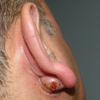Mod 3 Flashcards
What are the external structures of the eye?
Eyelids Lateral and medial canthus Eyelashes, conjunctiva Lacrimal apparatus Extraocular muscles

What are the internal structures of the eye?
Sclera, cornea, iris, ciliary body Pupil (3 to 5 mm) lens, choroid, retina, optic disc Physiologic cup, retinal vessels Anterior chamber, posterior chamber
What are risk factors for Cataracts?
Increasing age – developing at 30 years of age Exposure to ultraviolet B light Diabetes mellitus Cigarette smoking Alcohol use Diet low in antioxidant vitamins High blood pressure Eye injuries/surgery Steroid use Female gender Persistent diarrhea Gout Abdominal obesity Beta blocker use
What can you due to reduce risk for Cataracts?
Wear sunglasses Quit smoking Limit alcohol intake Avoid eye injuries Regular eye examinations
What is Cataracts?
clouding of the usually clear lens of the eye, causing a person to see as though looking through a frosty or foggy window.

What is Glaucoma?
an acute or chronic condition in which there is an increase of IOP which leads to damage of the retina and optic nerve, with resulting visual field loss.

What is referred to as the “silent thief of sight”
Glaucoma
What is Macular Degeneration?
age-related macular degeneration is the primary cause of vision loss in older adults. Does not affect peripheral vision. Affects ventral vision, color perception and fine detail which affects reading, driving and seeing faces.

What is Diabetic Retinopathy?
occurs in both type 1 & type 2 diabetes. Caused by changes in the small blood vessels in the retina. Changes in the microvasculature include microaneurysms, intraretinal hemorrhage, hard exudates, and focal capillary closure. Is painless

What are sign and symptoms of Glaucoma?
gradual loss of peripheral vision, blurred vision, “halos” around lights, difficulty focusing, difficulty adjusting eyes in low lighting, loss of peripheral vision, aching or discomfort around the eyes and/or headaches

What are sign and symptoms of Macular Degeneration?
blurred vision, straight lines which appear crooked
What are sign and symptoms of Diabetic Retinopathy?
floaters or cobwebs in the visual field, sudden visual changes including spotty or hazy vision or complete loss of vision. Many patients are asymptomatic
What is the leading cause of blindness worldwide?
Cataracts
What equipment will you need for a physical assessment of the eyes?
Snellen or E chart Hand-held Snellen card or near-vision screener Penlight Opaque cards Ophthalmoscope

What score is normal for distant acuity with or without corrective lenses?
20/20
How do you get the top number of a visual acuity score?
By how many feet the client is from the chart ex. 20/20 is 20 ft from the eye chat
How do you get the bottom number of a visual acuity score?
It is the number found on the chart row of the smallest print that the patient can read.
What score is normal for near acuity with or without corrective lenses?
14/14
What is associated with optic atrophy, glaucoma, or Vitamin A deficiency?
Night blindness

What is diplopia?
Double vision which may indicate increased ICP due to an injury or tumor.

While assessing extraocular muscle function how would you conduct the corneal light reflex test?
use penlight to observe parallel alignment of light reflection on corneas. Asymmetric position of the light reflex indicated deviated alignment of the eyes, possibly due to muscle weakness or paralysis.

While assessing extraocular muscle function how would you conduct the Cover test?
use opaque card to cover an eye to observe for eye movement. Tests for deviations in alignment or strength or slight deviations in eye movement
While assessing extraocular muscle function how would you conduct the Positions test (6 Cardinal Fields of Gaze)?
observe for eyes to follow movement symmetrically. Assesses eye muscle strength and cranial nerve function.

During physical inspection of the eyelids and eyelashes you notice drooping of the upper lid may be due to oculomotor nerve (CN II) damage, myasthenia gravis, weakened muscle tissue or damage, or congenital disorder what is it?
Ptosis


























